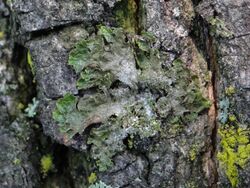Biology:Melanohalea elegantula
From HandWiki
Short description: Species of lichen in the family Parmeliaceae
| Melanohalea elegantula | |
|---|---|

| |
| Scientific classification | |
| Domain: | Eukaryota |
| Kingdom: | Fungi |
| Division: | Ascomycota |
| Class: | Lecanoromycetes |
| Order: | Lecanorales |
| Family: | Parmeliaceae |
| Genus: | Melanohalea |
| Species: | M. elegantula
|
| Binomial name | |
| Melanohalea elegantula (Zahlbr.) O.Blanco, A.Crespo, Divakar, Essl., D.Hawksw. & Lumbsch (2004)
| |
| Synonyms[1] | |
| |
Melanohalea elegantula, commonly known as the elegant camouflage lichen,[2] is a species of lichen in the family Parmeliaceae. It was first described by Alexander Zahlbruckner in 1894 as Parmelia aspidota var. elegantula. Hungarian lichenologist Ödön Szatala promoted it to full species status, as Parmelia elegantula, in 1930. Ted Esslinger transferred it to the genus Melanelia in 1978.[3] Finally, it was assigned to the newly circumscribed genus Melanohalea in 2004.[4]
References
- ↑ "Synonymy: Melanohalea elegantula (Zahlbr.) O. Blanco, A. Crespo, Divakar, Essl., D. Hawksw. & Lumbsch". Species Fungorum. http://www.speciesfungorum.org/Names/SynSpecies.asp?RecordID=364691.
- ↑ Brodo, Irwin M.; Sharnoff, Sylvia Duran; Sharnoff, Stephen (2001). Lichens of North America. Yale University Press. pp. 442–443. ISBN 978-0300082494.
- ↑ Esslinger, Theodore L. (1978). "A new status for the brown Parmeliae". Mycotaxon 7 (1): 45–54. http://www.cybertruffle.org.uk/cyberliber/59575/0007/001/0045.htm.
- ↑ Blanco, Oscar; Crespo, Ana; Divakar, Pradeep K.; Esslinger, Theodore L.; Hawksworth, David L.; Lumbsch, H. Thorsten (2004). "Melanelixia and Melanohalea, two new genera segregated from Melanelia (Parmeliaceae) based on molecular and morphological data". Mycological Research 108 (8): 873–884. doi:10.1017/S0953756204000723. PMID 15449592.
Wikidata ☰ Q10481209 entry
 |

